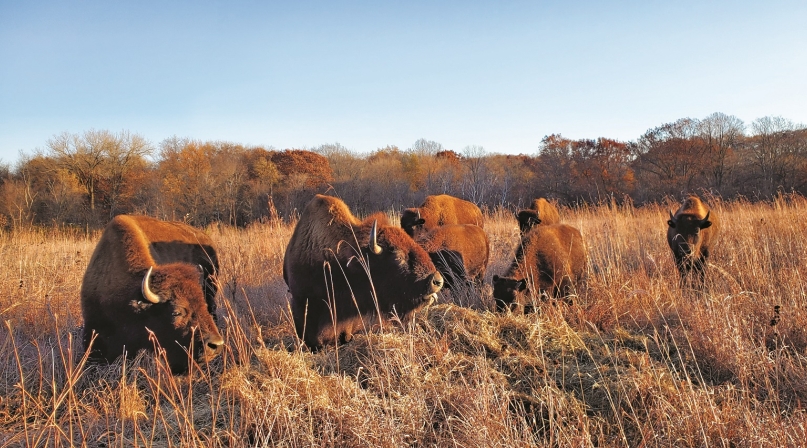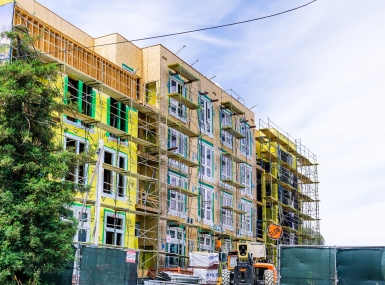Bison's comeback means big boost for a county's ecosystem

Key Takeaways
Bison are grazing the prairie in Dakota County, Minn. again for the first time in over a century.
In conjunction with the Minnesota Bison Conservation Herd, the county is reintroducing plains bison in Spring Lake Park Reserve to restore the prairie and benefit its ecosystem.
“Dakota County was around 80% prairie prior to European settlement,” said Tom Lewanski, Dakota County’s director of natural resources.
“Historically, the prairie was maintained by three natural processes — climate, fire and grazing,” he said.
“Obviously there’s not much we can do about climate on a local level; fire we do utilize as a tool as we restore and maintain these prairies, but we’re very interested in that third driver, the natural grazing, and the primary grazer on the prairie is the bison … they impact the ecosystem in so many various ways, so it’s been really exciting to reintroduce that piece.”
Bison are what Lewanski refers to as a “keystone species,” meaning if they’re removed from their native ecosystem, the ecosystem ceases to function in the same way.
Without the bison grazing, the prairie grass can get up to 6 feet tall, which prevents proper sunlight from getting to flowers, which then negatively impacts the area’s insects, birds and mammals.
“The bison impacts the prairie in so many other ways, too,” Lewanski said.
“They have a propensity to roll on the ground, called ‘waddling.’
“In a prairie, the plants are so thick that if you have a seed, their chances of finding mineral soil in that thick living and dead material is pretty slim. When bison waddle, they open up the mineral soil, so the seeds can have a place to germinate and start to grow.
“[Bison] can also weigh up to 2,000 pounds, so rolling around on the ground they tend to compact the soil to the extent that there’s a little divot in the earth that actually holds water, which provides drinking water for other animals on the prairie and a breeding habitat for frogs and toads, all the way to grassland bird species.”
In October 2022, eight bison were brought to Spring Lake Park Reserve from two state parks. There are now 12.
“It’s a living laboratory for us,” Lewanski said.
“It took over four years for us to plan and do this, so that allowed us to get our ecologist out there and we did a kind of pretreatment. ‘What are the plants? What are the butterflies, the mammals, reptiles, breeding birds?’
“So, we have a pretty good sense of what’s out there, and now that we reintroduced the bison, we will continue to do those studies over time so we can really document what impact the bison are having on our prairie in this particular park.”
The reintroduction was made possible through the state’s Environment and Natural Resources Trust Fund, which devoted $560,000 to build the necessary infrastructure, including fencing, gates and water troughs — “all the things that keep the bison and park visitors healthy and safe,” Lewanski said.
While Dakota County reintroduced the bison to help manage and restore the prairie, there was also an understanding that people would want to come out and see them, which was important to take into account when determining which park the bison would roam, Lewanski said.
“People really love this idea of bringing in the bison, knowing that this is a part of our history, of the heritage of this county,” Lewanski said. “There’s a greenway that goes through the park, so people jumping on their bikes or walking, they can wander between these paddocks and there’s great opportunities to view the bison.”
Another beneficial element of the initiative is how it celebrates the historic impact of bison for the Dakota people, who are indigenous to the region, according to Lewanski.
“The bison were such an integral part of these communities that it’s gratifying for us to be able to bring them back,” Lewanski said.
“It’s an opportunity for us to educate people and tell the story about the relationship between the bison and the Indigenous plains people that were here and are still here. Dakota people and bison had a close relationship for thousands of years.
“For the Dakota people, it was their grocery store, clothing, bedding, tools, food — it was also their pathway to the Creator Spirit, so this is an opportunity for us to help to tell that story, which I think is as important as the ecological story.”
Attachments
Related News

White House signs executive orders to boost coal industry
On April 8, President Trump signed four [RY1] [CM2] executive orders (EOs) focused on the U.S. coal industry, aligning with the Administration’s “Unleashing American Energy” EO signed in January 2025.

County Countdown – April 7, 2025
Every other week, NACo's County Countdown reviews top federal policy advocacy items with an eye towards counties and the intergovernmental partnership. This week features a budget reconciliation update, HHS restructuring and more.

